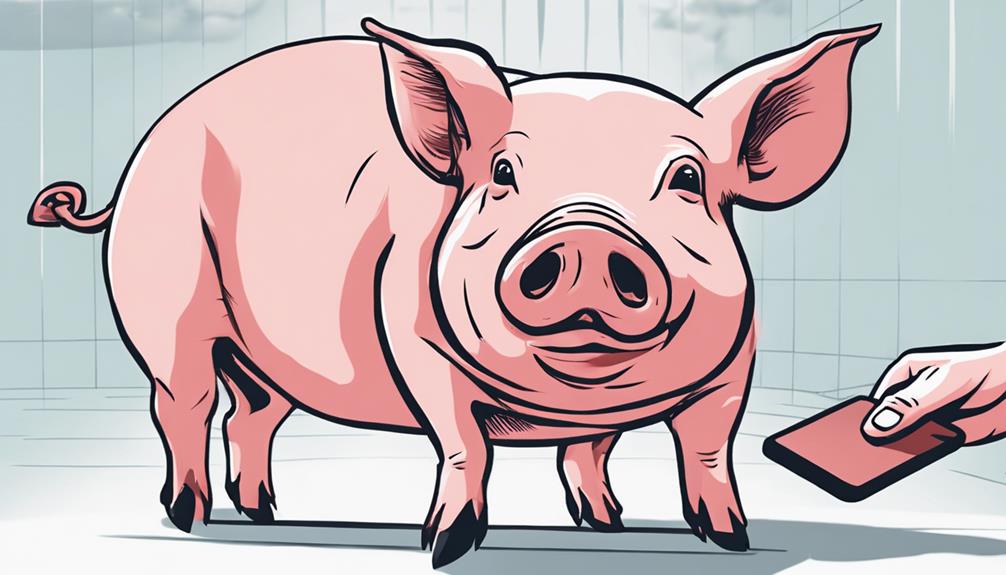Top 3 Effective Tips for Training Pigs Successfully
Did you know that pigs are highly intelligent animals, ranking fourth in animal intelligence after humans, primates, and dolphins?
Understanding how to effectively train them can lead to successful outcomes.
When it comes to training pigs, utilizing positive reinforcement, setting achievable goals, and establishing a consistent routine are paramount.
By following these top three tips, you can enhance your pig training skills and build a strong bond with your porcine companions.
Understand Pig Behavior
To successfully train pigs, understanding their behavior is crucial. By grasping pig psychology and recognizing behavioral cues, you can effectively communicate and train them. Pigs are intelligent animals with complex social structures and emotional capacities. Implementing proper handling techniques is essential to gaining their trust and cooperation.
When working with pigs, it's vital to be aware of their behavioral cues. Pigs communicate through various sounds and body language, such as wagging their tails when happy or nudging when seeking attention. Understanding these signals allows you to respond appropriately and build a stronger bond with your pigs. Additionally, being mindful of their natural behaviors, like rooting or exploring with their snouts, can help you create a more enriching training environment.
Proper stress management is key to successful pig training. Pigs are sensitive animals that can easily become stressed in unfamiliar or high-pressure situations. By creating a calm and consistent training environment, you can help reduce their stress levels and improve their learning capabilities. Avoid loud noises, sudden movements, or crowded spaces that can agitate the pigs. Instead, provide them with a quiet and comfortable space where they can focus on training tasks.
Use Positive Reinforcement
Implementing positive reinforcement techniques is essential for effectively training pigs. When it comes to pigs, reward training can be a powerful tool for behavior modification.
Here are five key points to keep in mind when using positive reinforcement:
- Consistency is Key: Ensure that you consistently reward the desired behavior to reinforce it effectively.
- Immediate Rewards: Offer the reward immediately after the pig performs the desired behavior to strengthen the association.
- Use Varied Rewards: Pigs, like humans, have preferences. Experiment with different types of rewards to see what motivates your pig the most.
- Keep Sessions Short and Sweet: Pigs have short attention spans, so keep training sessions brief but frequent for optimal results.
- Avoid Negative Reinforcement: Focus on rewarding positive behavior rather than punishing negative behavior. This approach encourages a more positive learning experience for the pig.
Be Consistent in Training
When training pigs, maintaining consistency in your approach is crucial for successful results. Consistent repetition of commands and reinforcement techniques helps pigs understand what's expected of them. Pigs are intelligent animals that respond well to routine and predictability. By being consistent in your training methods, you create a structured environment that aids in their learning process.
Behavior analysis is another key aspect of being consistent in pig training. Observing and analyzing your pig's behavior during training sessions can provide valuable insights. By consistently monitoring how your pig responds to different cues and rewards, you can tailor your training approach to suit their individual needs. For example, if a pig seems to struggle with a particular command, you can adjust your training method to help them grasp the concept better.
Consistency also helps in building trust and rapport with your pig. Pigs are more likely to respond positively to training when they feel secure and understand what's expected of them. By maintaining a consistent training schedule and approach, you establish a sense of stability that can strengthen your bond with your pig.
Set Achievable Goals
Consistently setting achievable goals is essential for successful pig training. Understanding what motivates your pigs and rewarding their progress are key aspects of setting effective goals. Here are some tips to help you set achievable goals for training your pigs:
- Know Your Pig's Personality: Each pig is unique, so understanding your pig's personality will help you set goals that are tailored to their specific needs and preferences.
- Start Small and Gradually Increase Difficulty: Begin with simple tasks and gradually increase the complexity as your pig learns and progresses. This approach will keep your pig motivated and engaged.
- Be Realistic: Set goals that are challenging yet attainable. Unrealistic goals can lead to frustration and demotivation for both you and your pig.
- Track Progress: Keep a record of your pig's progress to monitor how they're advancing towards their goals. This will also help you adjust your training techniques accordingly.
- Celebrate Achievements: Reward your pig whenever they achieve a goal or make significant progress. Positive reinforcement is a powerful tool in pig training and will encourage desired behaviors.
Establish a Routine
To ensure successful pig training, establish a consistent routine that provides structure and predictability for your pigs. Pigs thrive on routine and familiarity, so creating a consistent schedule for training sessions is crucial. Set specific times each day for training to help your pigs understand when to expect learning opportunities. By sticking to a routine, you create a sense of stability in their training environment, which can lead to faster progress and better retention of commands.
When establishing a consistent schedule, consider factors such as meal times and the pig's natural behavior patterns. Pigs are most alert and receptive after meals, making it an ideal time for training sessions. Additionally, pigs are creatures of habit, so try to schedule training sessions around the same time each day to help them feel comfortable and ready to learn.
Creating a structured training environment is equally important. Designate a specific area for training that's free from distractions and noise. This dedicated space will signal to your pigs that it's time to focus and work with you. Keep the training area consistent to avoid confusing your pigs and to reinforce the routine you've established.
Monitor Progress Regularly
Regularly monitoring the progress of your pigs during training is essential for gauging their development and adjusting your strategies accordingly. Tracking improvements and measuring growth allows you to make informed decisions on how to proceed with their training.
Here are five key points to consider when monitoring the progress of your pigs:
- Consistent Observation: Spend time daily observing your pigs during training sessions to notice any patterns or changes in behavior.
- Record Keeping: Maintain detailed records of each training session, noting milestones achieved and areas needing improvement.
- Physical Assessment: Regularly assess the physical condition of your pigs to ensure they're healthy and not experiencing any issues that could hinder their progress.
- Behavioral Changes: Pay attention to any shifts in behavior, as this could indicate discomfort, stress, or readiness to learn more advanced tasks.
- Feedback Loop: Encourage feedback from other trainers or experts to gain different perspectives on your pigs' progress and receive valuable insights on potential adjustments to your training methods.
Adjust Training Methods as Needed

When training pigs, be prepared to adjust your methods as needed to ensure their progress and development remain on track. Adaptability in training is key when working with pigs, as each pig is unique and may respond differently to various training techniques.
Flexibility in approach is crucial to successfully train pigs, as what works for one pig may not work for another.
To maintain adaptability in training, observe the pig's reactions closely during training sessions. If a particular method isn't yielding the desired results, be willing to switch to a different approach. For example, if a pig isn't responding well to verbal commands, try using hand signals or visual cues instead.
By being flexible and open to adjusting your training methods, you can cater to the individual needs and learning styles of each pig.
Additionally, consider the pig's environment when adapting your training methods. Factors such as noise levels, distractions, and the presence of other animals can impact the pig's focus and responsiveness. Make necessary adjustments to create a conducive training environment that allows the pig to concentrate and learn effectively.
Reward Success
Be sure to consistently reward success when training pigs to reinforce positive behavior and encourage desired responses. Incentivizing progress is crucial in pig training as it helps them understand which actions lead to rewards. Celebrating achievements creates a positive environment and motivates pigs to continue excelling.
Here are some key points to consider when rewarding success:
- Use treats effectively: Offer small, tasty treats immediately after the pig performs the desired behavior to reinforce the connection between the action and the reward.
- Provide verbal praise: Pigs respond well to positive reinforcement, so use a cheerful tone and encouraging words to let them know they're doing a good job.
- Use favorite toys: Some pigs are motivated by playtime with their favorite toys, so incorporating play as a reward can be highly effective.
- Maintain consistency: Be consistent in your rewards to avoid confusion and ensure that the pig understands what behavior is being reinforced.
- Mix up rewards: While treats are commonly used, varying the rewards can keep the pig engaged and interested in training sessions.
Frequently Asked Questions
How Do I Introduce New Pigs to an Established Training Routine?
When introducing new pigs to an established training routine, use gentle training techniques and socialization methods to help them adjust.
Start by slowly integrating them into the routine, providing positive reinforcement for their efforts. Allow time for the pigs to observe and learn from the established group.
Are There Any Specific Breeds of Pigs That Are Easier or More Difficult to Train?
When it comes to pig training challenges, different breeds can have behavioral differences that impact the training process. Some breeds may be easier to train due to their temperament and intelligence, while others might require more patience and consistency.
Understanding the specific characteristics of the breed you're working with can help you tailor your pig training methods for better success.
How Can I Address Aggression or Stubborn Behavior in Pigs During Training?
When handling aggression or stubbornness in pigs during training, focus on positive reinforcement and consistent training methods. Use rewards like treats or praise to encourage desired behaviors, and be patient and firm when correcting unwanted actions.
Establish clear boundaries and expectations to help pigs understand what's expected of them. By staying consistent and using positive reinforcement techniques, you can address aggression and stubbornness effectively in pig training.
Is It Necessary to Consult With a Veterinarian Before Implementing a Training Program for Pigs?
Before starting a training program for pigs, it's essential to consult with a veterinarian. This step is crucial as they can provide valuable insights on training techniques and ensure the well-being of your pigs.
Consulting with a vet is important for the success of your training program and the health benefits of your animals. Their expertise can help you address any potential issues and maximize the effectiveness of your training efforts.
What Are Some Common Mistakes That Can Hinder the Success of Pig Training Efforts?
When training pigs, common mistakes like inconsistent rewards or using harsh methods can hinder progress. Training challenges arise when you don't establish clear communication or have a structured routine.
To succeed, remember to be patient, use positive reinforcement, and stay consistent in your approach. Avoid rushing the process or expecting immediate results.
Conclusion
In conclusion, remember to understand pig behavior, use positive reinforcement, and be consistent in your training efforts.
By setting achievable goals, establishing a routine, and monitoring progress regularly, you can successfully train pigs.
Don't forget to adjust your training methods as needed and always reward their success.
With these effective tips in mind, you'll be on your way to training pigs successfully in no time.
